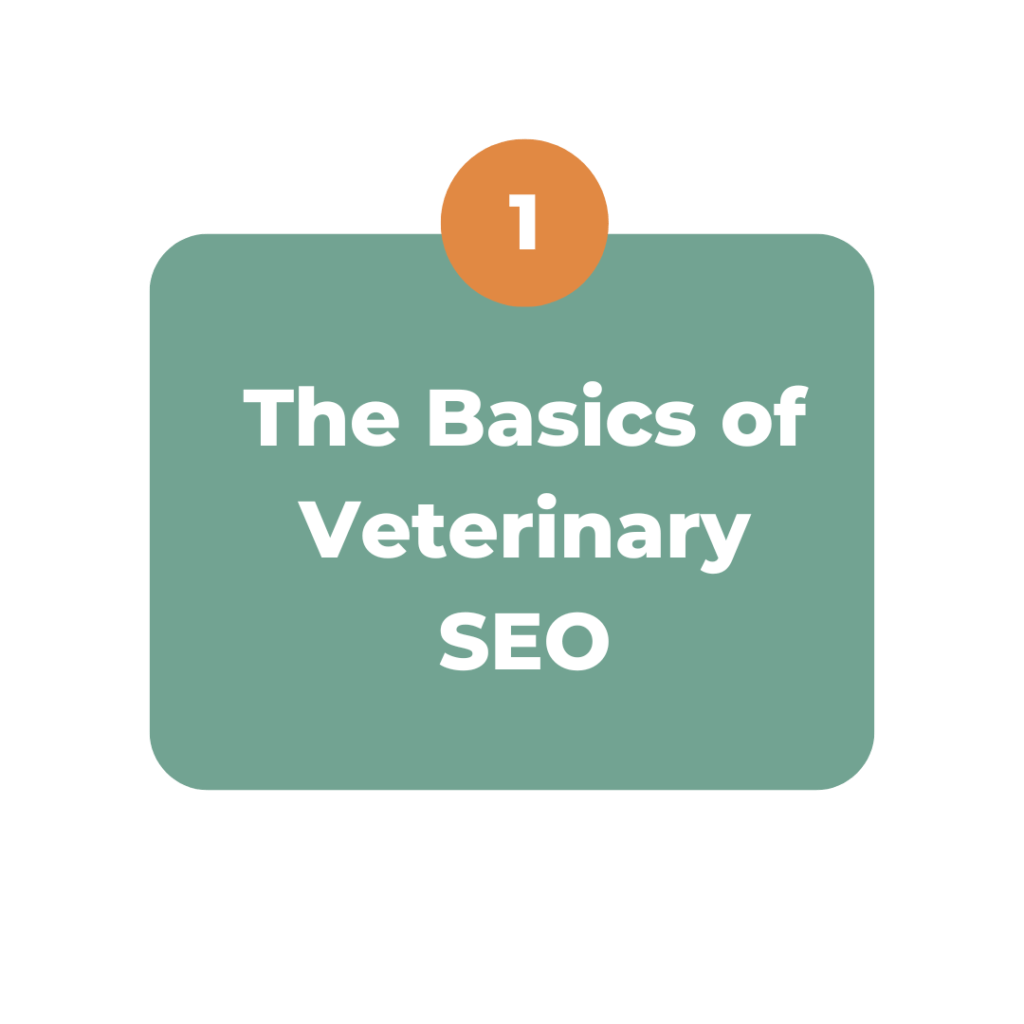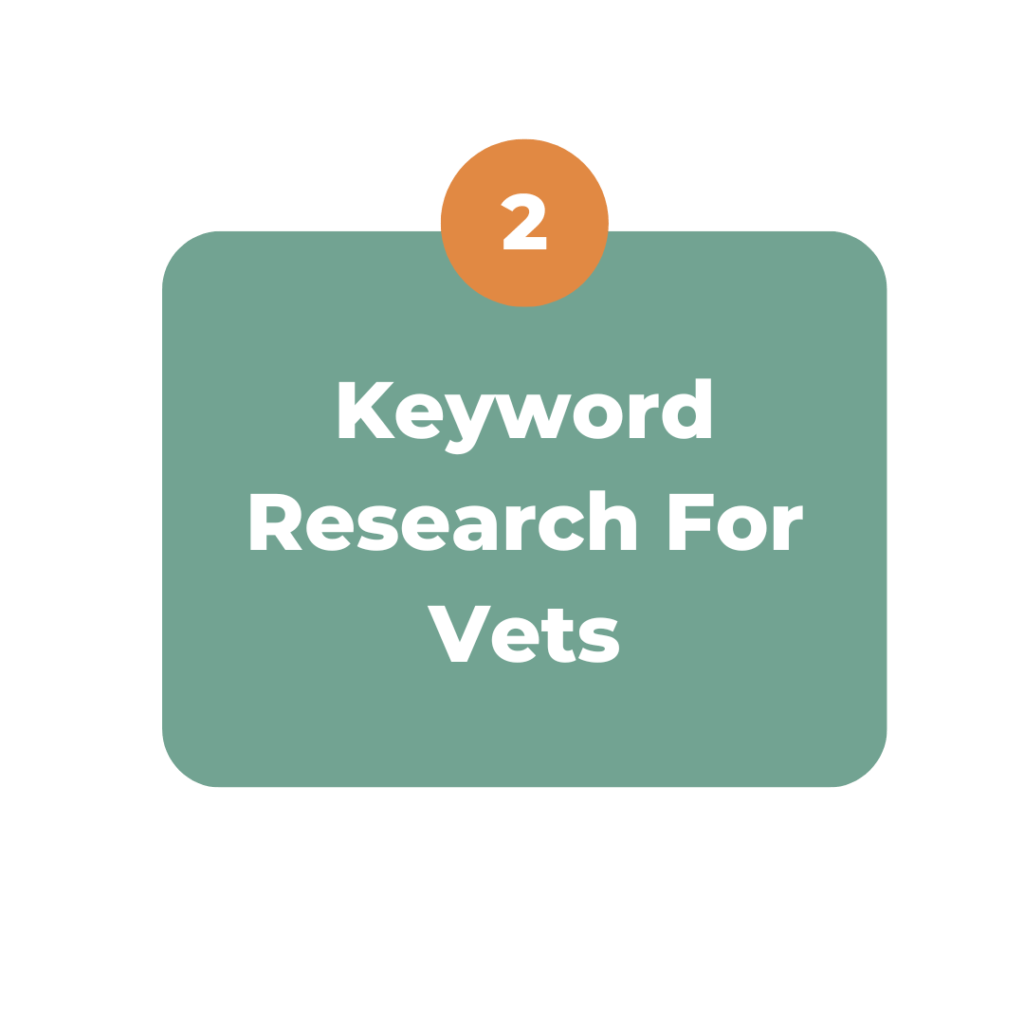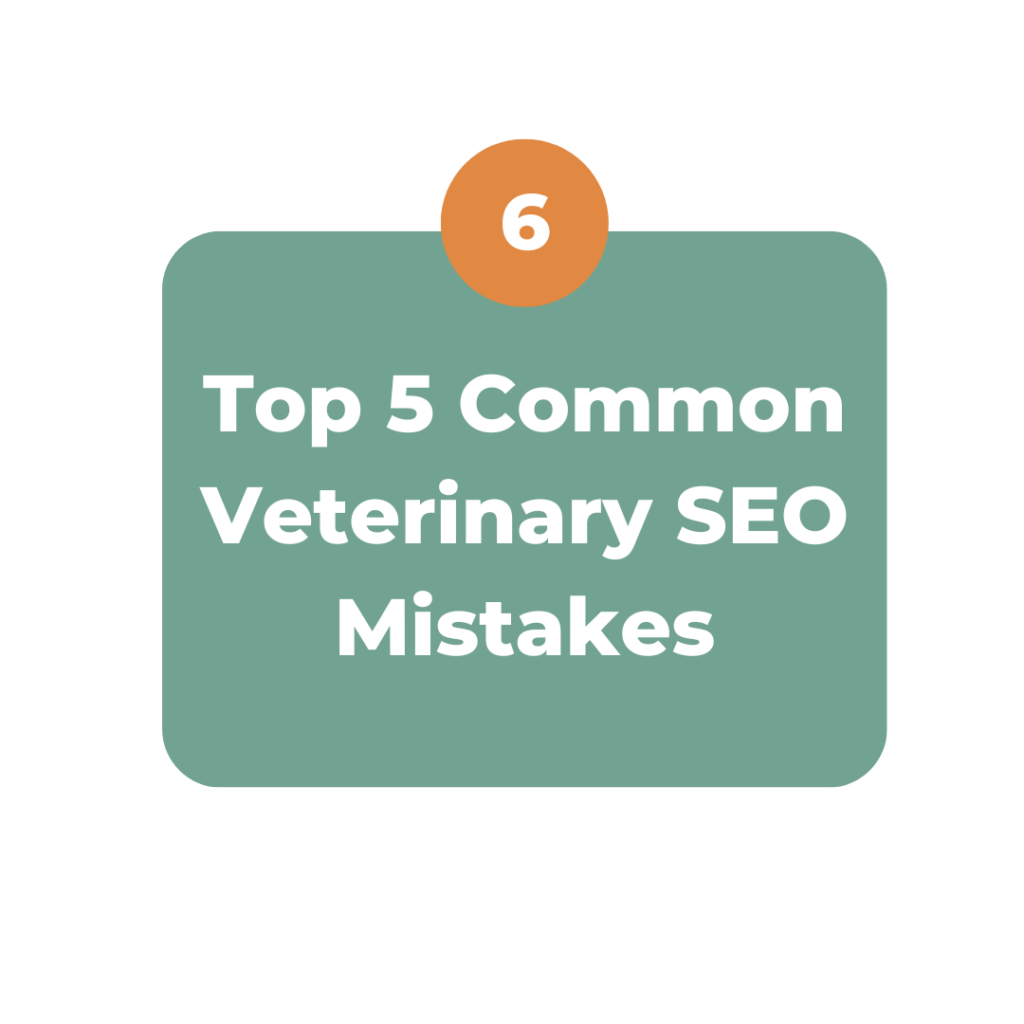SEO for Vets: How to Optimize Your Website & Google Listing
As a veterinarian, you dedicate your time to caring for animals, but what about caring for your online presence?
In today’s digital age, having a strong online presence is crucial for attracting new clients and growing your veterinary practice. That’s where veterinary SEO or veterinary search engine optimization comes into play.
In this guide, we’ll walk you through the steps to optimize your website and improve your visibility in local searches, helping you connect with pet owners in your area.

CHAPTER 1
The Basics of Veterinary SEO
What’s veterinary SEO?
SEO, or Search Engine Optimization, is the process of optimizing your website and online presence to improve your visibility in search engine results.
For veterinarians, this means ensuring that when pet owners search for services like yours, they find your practice among the top results.
This involves various strategies and techniques aimed at increasing your website’s organic (non-paid) traffic by improving its search engine rankings.
Why does veterinary SEO matter?
And with more pet owners turning to the internet to find veterinary services, having a well-optimized website can significantly impact your clinic’s success.
In 2025, competition among veterinary practices is fiercer than ever. According to LifeLearn’s State of Veterinary Marketing Report, 77% of practices are now planning more SEO or maintaining the same level of SEO.
Now you might be wondering…
How can my practice rank #1 on Google?
Google, the leading search engine, uses a multitude of factors to determine rankings, including the relevance and quality of content, website performance, user experience, and the authority of your site.
In this guide, we’ll show you how to optimize each of these factors to improve your ranking.
Let’s get started by looking at the three main types of SEO strategies for vets.
The types of veterinary SEO
Veterinary SEO can be generally divided into three types:
-
On-page SEO: Involves optimizing elements on your website, such as content and HTML source code, to improve your search engine rankings. On-page SEO includes keyword optimization, meta tags, internal linking, and content quality.
-
Off-page SEO: Focuses on activities outside of your website, such as link building and social media engagement, to increase your site’s authority and credibility. Off-page SEO includes strategies like guest blogging, veterinary social media marketing, and online reputation management.
-
Local SEO: Targets local searches and helps your veterinary clinic appear in local search results. Local SEO is essential for attracting clients in your area and includes strategies like optimizing Google My Business listing, local citations, and localized content.
In 2025, all three types of SEO are crucial for veterinary practices looking to improve their online visibility and attract more clients.
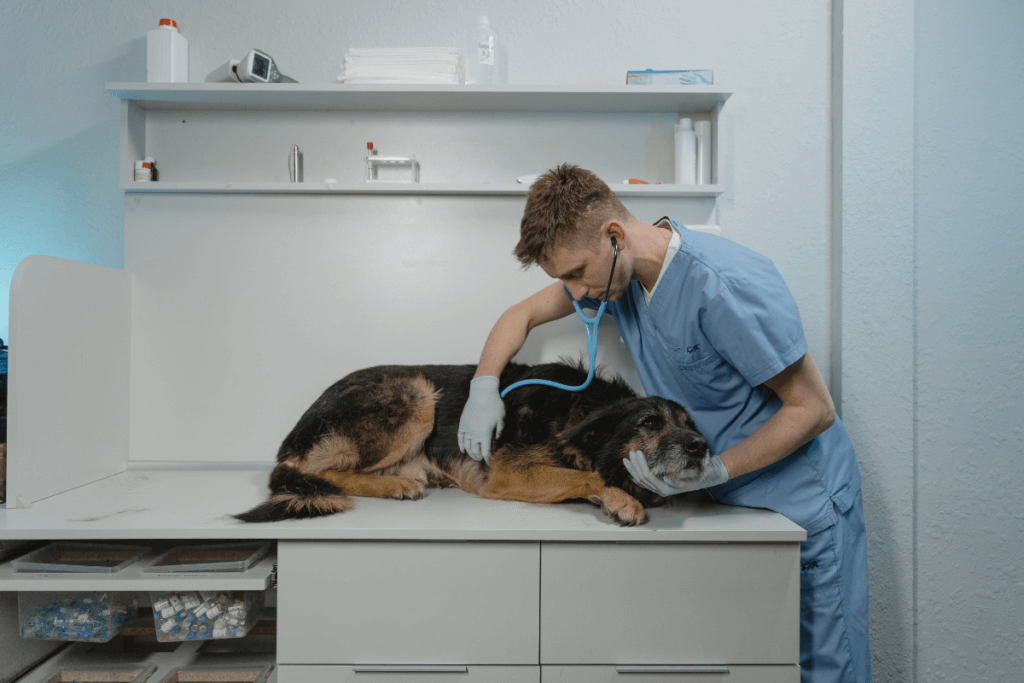
CHAPTER 2
Keyword Research For Vets
Keywords are the words and phrases pet owners type into search engines when looking for veterinary services. By targeting the right keywords, you can attract the most relevant traffic to your website.
Keyword research is the foundation of any successful SEO strategy. Let’s get started by exploring the two main types of SEO keywords.
The types of SEO keywords
There are two types of keywords to consider in your research:
- Short-tail keywords: These are short, general terms like “veterinary clinic” or “animal hospital near me”. Short-tail keywords have high search volume but are also highly competitive.
-
Long-tail keywords: These are longer, more specific phrases like “emergency vet clinic open 24/7” or “best pet surgery in [city].” Long-tail keywords have lower search volume but are less competitive and often result in higher conversion rates and more qualified traffic.
Keyword research tools
To conduct keyword research for your practice, you can use free or paid tools. Here are some of our favourite:
- Google Keyword Planner (free)
- Ubersuggest (free trial available)
- SEMrush (free trial available)
- Moz Keyword Explorer (free trial available)
- Ahrefs (free trial available)
These tools provide valuable insights into keyword search volume, competition level, and related terms, helping you identify the keywords that have the most business value for your veterinary practice.
Now that you understand the basics of SEO and keyword research, let’s dive into the optimizations you can make to your website that will help you rank higher on search engines.
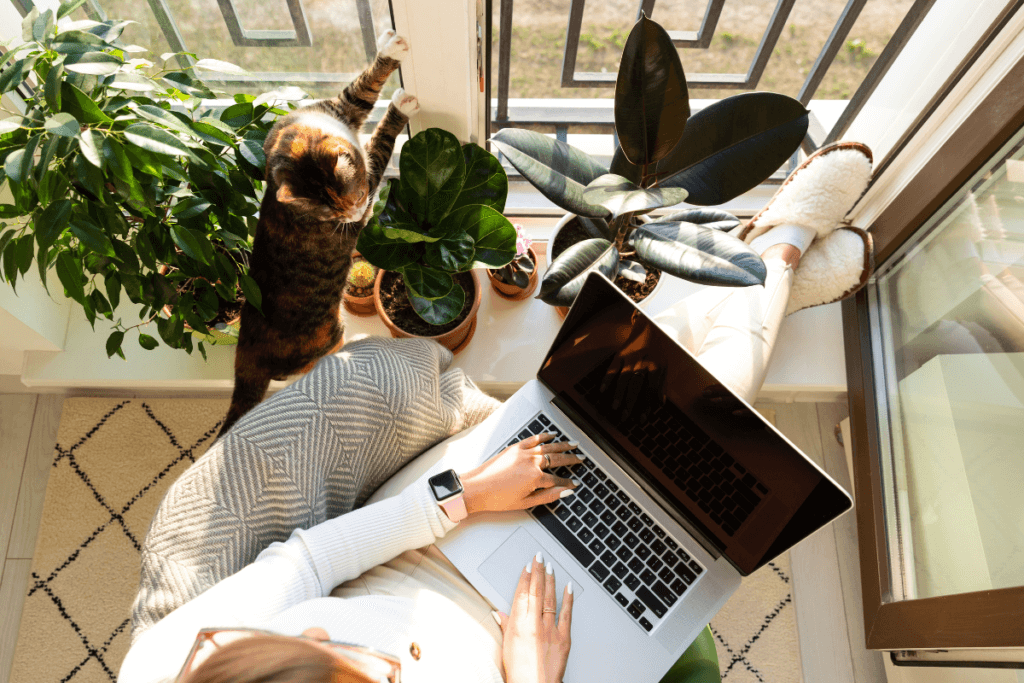
CHAPTER 3
Veterinary Website Optimization
6 tips for a SEO-friendly veterinary website
Your website is your digital storefront, and optimizing it for search engines is crucial for improving user experience and ranking higher.
Here are some tips for optimizing your veterinary website.
Tip #1: Conduct a website audit
Start by identifying any technical issues that may affect your website’s performance, such as broken links, duplicate content, and slow loading times.
Use tools like Google Search Console and Screaming Frog to conduct a comprehensive website audit.
Tip #2: Ensure mobile-friendliness
With the increasing use of mobile devices, it’s crucial to ensure that your website is mobile-friendly. Google prioritizes mobile-friendly websites in search results, so make sure your website is responsive and easy to navigate on smartphones and tablets.
To check if your website is properly optmized for mobile devices, use Google’s own PageSpeed Insights tool.
Tip #3: Create high-quality content
Content is king when it comes to SEO.
Create informative, engaging, and relevant content that addresses the needs and concerns of your target audience. Incorporate relevant keywords naturally into your content, but avoid keyword stuffing, as it can negatively impact your website’s rankings.
Tip #4: Optimize meta tags and headings
Meta tags are snippets of text that provide information about a webpage’s content to search engines. The three most important meta tags for SEO are the meta title, meta description and header tags.
- Meta title: This is the title of your webpage that appears as the clickable link in search engine results. It should accurately describe the content of the page and include relevant keywords to improve visibility.
- Meta description: The meta description is a brief summary of the webpage’s content that appears below the meta title in search results. It should be compelling and informative, enticing users to click through to your website. Including keywords in the meta description can also improve its relevance to search queries.
- Header tags: Header tags, also known as H1, H2, H3, etc., are HTML elements used to structure the content of a webpage. These tags not only make your content easier to read for visitors but also signal to search engines the importance of various sections of your page.
When optimizing your website, ensure that each page has a unique and descriptive meta title and meta description.
Additionally, use header tags to structure your content logically and include relevant keywords to improve its SEO performance.
Tip #5: Improve website speed
Website speed is a crucial ranking factor for search engines.
Optimize your website’s loading times by minimizing image sizes, leveraging browser caching, and using a content delivery network (CDN) to deliver content faster to users. Again, Google’s PageSpeed Insights is a handy tool to audit your website.
Tip #6: Optimize images
Use descriptive filenames and alt tags for your images to improve accessibility and provide search engines with context about your content. Optimized images can also appear in Google Image search results, driving additional traffic to your website.
That’s it! By taking the time to execute these simple website optimizations, you can improve your veterinary website’s search engine rankings and provide a better user experience for your visitors.

CHAPTER 4
Off-Site Optimization
How to generate backlinks to your veterinary website
Off-site optimization plays a crucial role in improving your website’s authority and credibility in the eyes of search engines.
Backlinks, or inbound links from other websites to yours, are one of the most important factors in off-site SEO.
Here are some simple ways to generate backlinks to your veterinary website:
-
Google Business Profile: Claim and optimize your Google Business listing to improve your visibility in local search results. Make sure your business information is accurate and up-to-date, including your address, phone number, and business hours.
-
Local directories and citations: Create profiles on local directories and citation websites like Yelp, Yellow Pages, and Angie’s List. Ensure your business information is consistent across all directories to improve your local SEO rankings.
-
Social media: Share valuable veterinary social media content channels like Facebook, Twitter, and Instagram to attract engagement and increase brand awareness. Encourage satisfied clients to leave positive reviews on your social media profiles and respond to customer feedback promptly.
-
Guest blogging: Identify reputable websites and blogs in the pet care and veterinary niche and reach out to them about guest blogging opportunities. Guest blogging allows you to showcase your expertise, reach a new audience, and earn backlinks to your website.
-
Online forums and communities: Participate in online forums and communities related to pet care and veterinary topics. Provide helpful advice and insights to community members and include a link to your website in your forum signature or profile.
-
Press releases and local news outlets: Write press releases about noteworthy events or achievements at your veterinary clinic and distribute them to local news outlets and online press release distribution services. Press releases can help you earn media coverage and backlinks from authoritative sources.
By implementing these off-site strategies, you can improve your veterinary website’s authority and credibility, leading to overall higher search engine rankings and increased organic traffic.

CHAPTER 5
Local SEO For Veterinarians
Local SEO is so important for veterinary businesses that it has its own chapter in this guide!
As we mentioned in Chapter 1, local SEO is essential for business with physical locations (like vets) because it helps your clinic appear in relevant local search results.
In this chapter, we’ll delve into a comprehensive 5-step checklist tailored to help you navigate the intricacies of local SEO and position your clinic as the go-to destination for pet care in your community.
Step 1: Optimize your website with localized content
Tailoring your website content and keywords to reflect local pet-related interests and concerns is key to capturing the attention of nearby pet owners.
Consider incorporating regional pet health issues, such as prevalent diseases or environmental hazards, into your content strategy to address the specific needs of your community.
Utilizing location-based keywords in your website’s meta tags, headings, and content not only improves your visibility in local search results but also helps establish relevance and authority within your geographic area.
Step 2: Optimize your Google Business Profile
Your Google Business Profile is often the first impression pet owners have of your veterinary practice in online search results.
By claiming and optimizing your listing, you can ensure that accurate information about your clinic, including business hours, contact details, and services offered, is readily available to pet owners searching online.
Here are some tips to ensure your Google Business listing is fully optimized:
-
Complete Your Profile: Fill out all available fields in your profile, including your practice name, address, phone number, website URL, business hours, and services offered.
-
Choose the Right Categories: Select relevant categories that accurately describe your veterinary practice, such as “Veterinary Clinic” or “Animal Hospital.”
-
Add High-Quality Photos and Videos: Visual content showcasing your clinic, staff, and furry patients can significantly enhance the appeal of your listing. Upload high-quality photos and videos that highlight your facilities, team, environment, etc.
-
Write Compelling Descriptions: Craft a compelling business description that effectively communicates your unique value proposition and the services you offer. Use relevant local keywords naturally like your city’s name throughout your description to improve your listing’s visibility in local search results.
-
Regularly Post Updates and Special Offers: Keep your listing fresh and engaging by regularly posting updates, announcements, photos and special offers. Aim to update your profile at least once a week.
-
Monitor and Respond to Reviews: Actively monitor and respond to reviews on your listing, thanking satisfied clients for their positive feedback and addressing any concerns or issues raised in negative reviews.
Step 3: Optimize other local citations and directories
Consistent and accurate business citations across online directories and platforms are essential for local SEO success.
For veterinary practices, this means ensuring that your clinic is listed correctly on industry-specific directories such as VetRatingz and VetHelpDirect, as well as general directories like Yelp and Yellow Pages.
Additionally, exploring niche pet-related directories and platforms can expand your online presence within the pet owner community.
By actively managing and updating your business information across these directories, you improve your chances of being discovered by local pet owners seeking veterinary services.
Step 4: Encourage and manage reviews
Encouraging satisfied pet owners to leave positive reviews on platforms like Google, Yelp, and Facebook not only boosts your online reputation but also improves your visibility in local search results.
When it comes to managing your reputation, it’s essential to respond promptly and professionally to all reviews, whether positive or negative, demonstrating your commitment to excellent pet care and customer service.
Step 5: Find opportunities for local link building
By partnering with animal shelters, pet rescues, and pet-friendly businesses, you can earn relevant backlinks and strengthen your local authority within the pet owner community.
Consider sponsoring or participating in community events, such as pet adoption drives or charity fundraisers, and leveraging these opportunities for online visibility. By aligning your practice with reputable organizations and businesses, you enhance your credibility and appeal to potential clients seeking pet care services near you.

CHAPTER 6
Top 5 Common Veterinary SEO Mistakes
We get it – SEO can feel like a bit of a jungle for veterinary practices navigating the digital terrain and mistakes happen.
But knowing and avoiding these common mistakes will put ahead of 99.9% vet brands out there.
Here are 5 common mistakes veterinarians should watch out for when it comes their SEO efforts:
Mistake #1: Ignoring local SEO
Many veterinary practices overlook the importance of local SEO, which can significantly impact their visibility in local search results. Make sure your business information is accurate and consistent across all online platforms, and optimize your website for local keywords and phrases.
Mistake #2: Keyword stuffing
Stuffing your website’s content with excessive keywords in an attempt to manipulate search engine rankings is a black hat SEO tactic that can result in penalties from search engines. Focus on creating high-quality, informative content that naturally incorporates relevant keywords and provides value to your audience.
Mistake #3: Neglecting website maintenance
Regularly update your website’s content, fix broken links, and address technical issues to improve user experience and search engine rankings. Neglecting website maintenance can lead to poor performance and decreased visibility in search results.
Mistake #4: Purchasing backlinks
Buying backlinks from low-quality or irrelevant websites is a black hat SEO tactic that can harm your website’s rankings and reputation. Focus on earning high-quality backlinks from reputable websites through guest blogging, veterinary social media marketing, and other legitimate strategies.
Mistake #5: Ignoring user experience
User experience is a crucial ranking factor for search engines. Make sure your website is easy to navigate, mobile-friendly, and optimized for fast loading times. Provide valuable content and a seamless browsing experience for your visitors to improve engagement and rankings.

What's Next?
Now that you’ve learned about the fundamentals of veterinary SEO and various strategies for improving your clinic’s online visibility, it’s time to take action.
Here are some actionable takeaways that you can implement right away for immediate results:
1. Conduct a comprehensive website audit today!
Use tools like Google Search Console, SpeedInsights and Screaming Frog to identify any technical issues that may affect your website’s performance. Addressing these issues can improve your website’s user experience and search engine rankings.
2. Research your targeted keywords
As highlighted in Chapter 2, keywords serve as the bedrock of SEO. That’s precisely why the second task on your SEO checklist is conducting keyword research. Leverage the free tools discussed earlier in Chapter 2 to delve into potential keyword opportunities for both optimizing your website and crafting compelling content.
3. Optimize your Google Business listing
Claim and optimize your Google Business listing with accurate business information, high-quality images, and positive reviews from satisfied clients. A well-optimized listing can improve your visibility in local search results and attract more clients to your clinic.
4. Create high-quality, informative content for your website
Develop content that addresses the needs and concerns of your target audience, such as pet care tips, informative articles, and client testimonials. Incorporate relevant keywords naturally into your content to improve its visibility on search engines.
5. Engage with your audience on social media
Share valuable content, engage with your followers, and respond to customer feedback on social media platforms like Facebook, Twitter, and Instagram. Building a strong veterinary social media presence can increase brand awareness and drive traffic to your website and, ultimately, improve your rankings.
6. Build relationships with local influencers and bloggers
Identify local influencers and bloggers in the pet care and veterinary niche and reach out to them about potential collaborations or guest blogging opportunities. Building relationships with local influencers can help you reach a wider audience and earn valuable backlinks to your website.
Conclusion
Veterinary SEO is essential for improving your clinic’s online visibility and attracting more clients.
By following the steps outlined in this comprehensive guide, you can optimize your website for search engines and rank higher in local search results.
From conducting keyword research and website optimization to off-site optimization strategies like generating backlinks and avoiding common SEO mistakes, there are numerous ways to improve your veterinary website’s search engine rankings and attract more organic traffic.
If you need further assistance with your SEO strategy or have any questions, feel free to contact us for a free consultation via this form. We’re here to help you succeed in the digital world of veterinary marketing!
